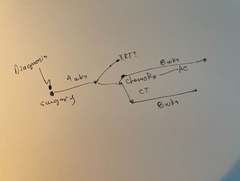Introduction
Chemotherapy often plays a crucial role in cancer treatment by using powerful medicines to fight cancer cells in the body. These drugs work by either killing the rapidly dividing cancer cells or slowing down their growth. Chemotherapy is designed to target cancer cells specifically, helping to shrink tumors and stop the cancer from spreading to other parts of the body. However, normal cells in the body can also be damaged. Unintended damage to normal cells can lead to chemotherapy side effects, like hair loss and nausea. Cancer doctors customize chemotherapy treatments to suit each patient's needs and the type of cancer they have. For many cancers, chemotherapy is an essential tool.
The three most effective chemotherapy agents for breast cancer are Adriamycin (also known as doxorubicin), Cytoxin (cyclophosphamide), and Taxol (paclitaxel). Two or three of these drugs may be combined and given in a cancer treatment regimen. One commonly used regimen is called AC-taxol (or AC->T). The AC-T regimen first combines two different chemotherapy drugs, Adriamycin (A) and cyclophosphamide(C) for two to three months. Later comes a switch to Paclitaxel (Taxol) alone.
Adriamycin and cyclophosphamide work by damaging the DNA inside cancer cells, interfering with their ability to reproduce and grow. Paclitaxel, on the other hand, interferes with the cell division process, making it harder for cancer cells to grow and spread. This combination helps doctors target cancer cells from multiple angles, improving the chances of successful treatment.
Other combinations of the A C and T drugs drugs are sometimes used, including TAC, T then AC, and sometimes the toxic Adriamycin is left out, leading to the TC (Taxol and cyoclophosphamide, or Taxotere ( a close relative of Taxol) and cyclophosphamide. We will concentrate on the AC-T combination here.
Key Takeaways
- Chemotherapy is a type of cancer treatment that uses powerful medicines to stop or slow down the growth of cancer cells in the body.
- One type of chemotherapy treatment given to some patients is called AC followed by Taxol (AC-T, or AC-Taxol).
- AC-Taxol is a combination of three chemotherapy drugs used together to fight the cancer cells.
What is AC followed by Taxol Chemotherapy?
The AC-Taxol regimen is a cancer treatment plan that combines three different drugs: Adriamycin, cyclophosphamide (AC), and paclitaxel (Taxol). Typically, the treatment lasts for several months, with cycles occurring every two to three weeks. During each cycle, patients receive the AC drugs first, followed by Taxol. This combination aims to attack cancer cells in various ways, disrupting their growth and division.
The AC-Taxol regimen is often prescribed for cases of breast cancer, particularly for those with larger tumors or where the cancer has spread to the lymph nodes. It can help shrink tumors before surgery, reduce the risk of cancer recurrence, or treat advanced cases. Doctors carefully consider a patient's specific cancer type and stage before recommending this regimen, tailoring the treatment to individual needs.
How is the Treatment Administered?
In the AC-Taxol chemotherapy treatment, drugs are typically administered through intravenous (IV) infusion, which means the medications are delivered directly into the patient's bloodstream through a needle. With the AC-Taxol combination, it’s often advantageous to have an intravenous port placed. A port is safer, and allows for easier access to the veins rather than having an IV needle inserted each time.
The treatment follows a specific schedule with cycles that occur every two to three weeks, allowing the body time to recover between doses. During each cycle, patients first receive the AC drugs, adriamycin and cyclophosphamide. Taxol cycles, either every week or every three weeks, follow. This carefully planned timing and dosage help target cancer cells effectively while minimizing side effects and allowing healthy cells to recover. Each part of the regimen is repeated several times, usually for a total of four to six cycles, as determined by the patient's medical condition and response to the treatment.
Potential Side Effects and their Management
Common side effects of the AC-Taxol chemotherapy treatment include:
- Fatigue, where patients may feel extremely tired and lacking in energy
- Nausea and vomiting may also happen, but medications can help manage these symptoms
- Hair loss is a possible side effect
- Less common but more serious side effects can include a decrease in blood cell counts, which can lead to an increased risk of infections or bleeding. Heart problems, such as weakening of the heart muscle, can occur, although it is less frequent.
To manage and help control these side effects, doctors often provide medications to help control nausea and vomiting. Patients are encouraged to maintain a balanced diet and stay hydrated to combat fatigue. Hair loss is typically temporary, with hair regrowth after treatment. Monitoring blood cell counts is important to catch any issues early, and in cases of heart concerns, close monitoring and medication adjustments can be recommended by a doctor. Open communication with the medical team about side effects is essential, as they can provide guidance and make necessary adjustments to the treatment plan to ensure the best possible outcome while minimizing discomfort.
Also Read: Taxol 12 weekly treatments side effects
What to Expect During Treatment
During AC-Taxol chemotherapy treatment, patients often experience various reactions during their sessions. While receiving the medications through an IV, some may feel:
- a warming sensation or experience a metallic taste in their mouth
- feel cold or shiver due to the Taxol infusion.
To ensure the treatment is effective and safe, healthcare providers closely monitor patients throughout the sessions. They regularly check vital signs like blood pressure, heart rate, and temperature. Blood tests are also conducted to assess blood cell counts, which can drop during treatment, and to evaluate liver and kidney function. These monitoring and tests are essential to track the body's response to the chemotherapy and make any necessary adjustments to the treatment plan to ensure the best possible outcome.
The Importance of Emotional Support During Treatment
AC-Taxol chemotherapy treatment can be physically and emotionally challenging, making mental and emotional support incredibly important. Patients often face anxiety, fear, and stress throughout their cancer experience. Having a strong support system of family, friends, and healthcare professionals can make a significant difference. Talking openly about feelings and concerns with loved ones or joining support groups can provide comfort and understanding. Additionally, seeking counseling or therapy can help patients navigate the emotional ups and downs that come with treatment. A positive mindset and emotional support can improve overall well-being, help cope with side effects, and enhance the effectiveness of the treatment.
Cancer Maps to help you find your way, one decision at a time.Built for Patients, by Patients. Backed by World-Leading Oncologists

The Role of Caregivers during AC-Taxol Treatment
Caregivers play a crucial role in the AC-Taxol chemotherapy treatment journey. They provide both physical and emotional support to the patient. This includes helping with daily tasks, offering comfort during tough times, and being a listening ear for the patient's concerns and fears. Caregivers also play a vital role in monitoring for side effects, like changes in vital signs or unusual symptoms, and ensuring that any issues are promptly communicated to the medical team. Their presence and care not only ease the patient's burden but also contribute to a more effective and safer treatment experience, fostering a sense of teamwork in the fight against cancer.
Also Read:
- Weight gain while on Tamoxifen
- How To Lose Weight On Letrozole
- TCHP Chemo: Which Days Are the Worst?
- Tamoxifen Withdrawal Symptoms
Conclusion
Chemotherapy is a powerful tool in fighting cancer, primarily by targeting and disrupting the growth of cancer cells. The AC-Taxol regimen combines Adriamycin, cyclophosphamide, and paclitaxel to enhance its effectiveness, often prescribed for breast cancer cases. Treatment is administered through intravenous infusion in cycles, allowing the body to recover between doses. Side effects like fatigue, nausea, and hair loss can occur but can be managed with medication and proper care. Close monitoring and tests during treatment sessions ensure safety and effectiveness. Emotional support is crucial during this challenging journey, and caregivers play a vital role in providing both physical and emotional support, as well as observing and communicating any side effects to the medical team. Together, these elements create a holistic approach to AC-Taxol chemotherapy treatment, helping patients navigate their cancer journey with care and support.
And remember, it's essential for patients and caregivers to seek guidance and personalized advice from medical professionals to make informed decisions and ensure the best care during cancer treatment. Medical experts can provide tailored recommendations based on individual health needs and treatment progress. You are not alone in your journey. Manta Cares was created by a cancer survivor for others touched by cancer. Join our global community for access to resources, tools and support to help make your cancer experience, or that of your loved one, just a little easier.
Take charge with free, expert-crafted resources from Manta Cares—designed to support and empower cancer patients and their caregivers every step of the way. Explore now!
-
FREE Chemotherapy Checklist for Caregivers
- FREE Quick Start Guide to a Cancer Diagnosis
- FREE Gift-Giving Guide
- FREE Caregiver Communication Guide
- Life Wheel Audit: A simple exercise to re-center, re-prioritize and re-start new habits
- Eating the rainbow. Free shopping guide
- Free Financial Checklist for Cancer Treatment
- FREE Reflection Exercise
FAQs on Side Effects of AC followed by Taxol Chemotherapy
Q: Is Adriamycin and Cytoxan followed by Taxol?
Ans - Yes, Adriamycin and Cytoxan (AC) are sometimes followed by Taxol in the AC-Taxol chemotherapy regimen.
Q: When do Taxol side effects start?
Ans - Taxol side effects can begin shortly after the infusion or within a few hours, with symptoms like allergic reactions, nausea, or muscle pain becoming noticeable in the immediate post-treatment period. These side effects are closely monitored by healthcare providers during the treatment session to ensure prompt management and patient comfort.
Q: What are the symptoms of a Taxol reaction?
Ans - Symptoms of a Taxol reaction can include shortness of breath, chest pain, severe dizziness, hives, swelling of the face, lips, tongue, or throat, and a rapid or irregular heartbeat. It's essential to report any unusual or severe symptoms immediately to the medical team administering the treatment for prompt intervention.
Q: Does AC chemo get worse with each treatment?
Ans - AC chemotherapy doesn't necessarily get worse with each treatment. Many patients find the side effects are easier to tolerate with each cycle. They often say they know what to expect with each cycle and can anticipate the need for anti nausea medications before symptoms occur. Medicines to manage side effects are often added or adjusted with each cycle, making the cycles easier to tolerate. Some side effects may accumulate over time. Patients may experience increasing fatigue or cumulative effects.
Q: Which chemo is worse, AC or Taxol?
Ans - The severity of side effects can vary from person to person, but some individuals may find AC chemotherapy to be more challenging due to potential side effects like nausea and fatigue, whereas Taxol may cause neuropathy or joint pain. It's crucial to discuss the potential side effects and your specific situation with your medical team to determine which chemotherapy regimen is more suitable for your condition.
Q: How many days after AC chemo do you feel better?
Ans - The timeframe for feeling better after AC chemotherapy can vary widely among individuals, but many patients may start to experience some improvement in their symptoms within a few days to a week after the treatment. However, it's essential to note that the recovery period can be influenced by factors such as the individual's overall health, the specific cancer being treated, and the treatment plan, so it's best to consult with the medical team for personalized guidance.
Q: What to expect after AC chemo?
Ans - After AC chemotherapy, it's common to experience side effects like fatigue, nausea, and hair loss, which can last for several days to weeks. Additionally, you might have fluctuations in energy levels and may require time to recover before the next treatment cycle, as AC chemotherapy can have a cumulative effect on the body.
Q: How well is weekly Taxol tolerated?
Ans - Weekly Taxol is often well-tolerated by many patients, as the lower dose and more frequent schedule can help reduce certain side effects associated with the medication. However, individual responses can vary, and some individuals may still experience side effects such as fatigue, neuropathy, or joint pain, so it's essential to discuss any concerns with your healthcare team to ensure the most suitable treatment plan.
Q: How long does it take for hair to fall out after AC chemo?
Ans - Hair loss, which is a common side effect of AC chemotherapy, typically begins within one to three weeks after starting the treatment. The exact timing can vary among individuals, but it's important to be prepared for this potential side effect and consider hair alternatives such as wigs or scarves if desired.
Q: Does chemo get worse the more sessions you have?
Ans - Chemotherapy side effects can vary from person to person, and while some individuals may experience cumulative side effects as they undergo more sessions, others may not necessarily find it progressively worse. The impact of chemotherapy on an individual's well-being can be influenced by factors like the specific drugs used, the type and stage of cancer being treated, and the individual's overall health.
Q: How many times can you have AC chemo?
Ans - The number of AC chemotherapy cycles a patient can have depends on several factors, including the type and stage of cancer and the individual's response to treatment. Typically, patients receive four to six cycles of AC chemotherapy, but the specific recommendation is made by the medical team based on the patient's unique circumstances.
Q: Is Taxol easier than AC chemo?
Ans - The ease or difficulty of Taxol compared to AC chemotherapy can vary from person to person. While Taxol may cause different side effects, some individuals may find it more manageable than AC chemotherapy, as it often has a lower risk of nausea and vomiting. However, the choice between the two treatments depends on the individual's specific cancer type and personal response to the medications, and it's important to discuss the options thoroughly with the medical team.
Q: Describe AC-Taxol chemotherapy for breast cancer.
Ans - AC-Taxol chemotherapy for breast cancer is a treatment plan that combines two different chemotherapy drugs, Adriamycin (A) and cyclophosphamide (C), with paclitaxel (Taxol) to enhance their effectiveness. Typically administered through intravenous infusion in cycles, this regimen aims to target and disrupt cancer cell growth in various ways, making it a common choice for breast cancer cases, particularly for those with larger tumors or lymph node involvement, helping to shrink tumors before surgery, reduce the risk of cancer recurrence, or treat advanced cases.
Q: Worst days after AC chemo?
Ans - The worst days after AC chemotherapy often occur within the first few days following treatment. During this period, patients may experience severe fatigue, nausea, and weakness, which can gradually improve over the next week as the body starts to recover from the impact of the chemotherapy drugs. This varies by individual.
Q: Long-term side effects of AC chemotherapy?
Ans - Long-term side effects of AC chemotherapy can include potential impacts on the heart, such as weakening of the heart muscle, which may require ongoing monitoring and management. Additionally, some individuals may experience persistent changes in blood cell counts or fertility issues as a result of the treatment, necessitating ongoing medical attention and support.
Disclaimer: The content provided by Manta Cares Inc. is intended for educational purposes only and is not a substitute for professional medical advice, diagnosis, or treatment. Always seek the advice of your physician or other qualified health providers with any questions you may have regarding a medical condition. Never disregard professional medical advice or delay seeking it because of something you have read on this website.
While we strive to keep the information up to date and correct, we make no representations or warranties of any kind, express or implied, about the completeness, accuracy, reliability, suitability, or availability with respect to the website or the information, products, services, or related graphics contained on the website for any purpose. Any reliance you place on such information is therefore strictly at your own risk.
The use of our platform does not create a doctor-patient relationship. Manta Cares Inc. does not recommend or endorse any specific tests, physicians, procedures, opinions, or other information that may be mentioned on the site. Reliance on any information provided by Manta Cares Inc., Manta Cares Inc. employees, others appearing on the site at the invitation of Manta Cares Inc., or other visitors to the site is solely at your own risk.
The site may contain health- or medical-related materials that are sexually explicit. If you find these materials offensive, you may not want to use our site. The site and the content are provided on an "as is" basis.





